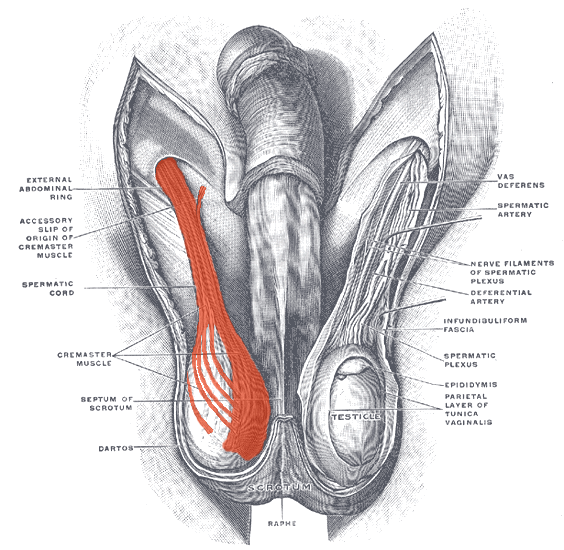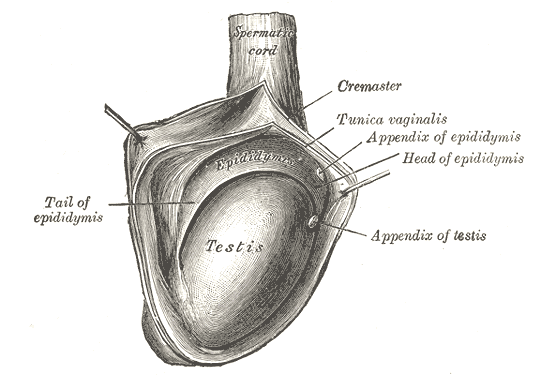Cremaster muscle
Overview
The cremaster muscle is a muscle that covers the testis.
Contraction
Its function is to raise and lower the scrotum in order to regulate the temperature of the testis and promote spermatogenesis.
In a cool environment the cremaster draws the testis closer to the body preventing heat loss, while when it is warmer the cremaster relaxes allowing the testis to cool.
Clinically, a reflex arc can be demonstrated by lightly stroking the skin of the inner thigh downwards from the hip towards the knee. This causes the cremaster muscle on the same side to rapidly contract, raising that testicle. This so called cremasteric reflex is much more pronounced in boys than in men.
The cremaster can also be contracted voluntarily, by contracting the PC muscle (using Kegels), or by sucking in the abdomen. Not all males are capable of doing this, as it requires pelvic muscle strength.
Development and gender differences
The cremaster develops to its full extent only in males; in females it is represented by only a few muscle loops.
In human females, the cremaster muscle is smaller and is found on the round ligament.
In rats, it has been shown that cremaster muscles developed from the gubernacular bulb.
Structure
In human males, the cremaster muscle is a thin layer of skeletal muscle found in the inguinal canal and scrotum between the external and internal layers of spermatic fascia, surrounding the testis and spermatic cord. The cremaster muscle is a paired structure, there being one on each side of the body.
Anatomically, the lateral cremaster muscle originates from the internal oblique muscle, just superior to the inguinal canal, and the middle of the inguinal ligament. The medial cremaster muscle, which sometimes is absent, originates from the pubic tubercle and sometimes the lateral pubic crest. Both insert into the tunica vaginalis underneath the testis.
Innervation and vascular supply
The cremaster muscle is innervated from the genital branch of the genitofemoral nerve and supplied by the cremasteric artery.
It receives distinctly different innervation and vascular supply in comparison to the internal oblique.
Popular culture
Matthew Barney's film sequence The Cremaster Cycle used the cremaster muscle as its conceptual point of departure.
Etymology
The word is derived from the Greek verb κρεμάννυμι = "I hang (transitive)", not from Latin cremare.
Additional images
-
The scrotum.
-
The right testis, exposed by laying open the tunica vaginalis.
External links
- Template:GPNotebook
- Template:MuscleLoyola
- Template:SUNYAnatomyLabs - "Inguinal Region, Scrotum and Testes: Layers of the Spermatic Cord"
- Template:EMedicineDictionary
de:Musculus cremaster it:Muscolo cremastere nl:Musculus cremaster Template:Jb1 Template:WH Template:WS

